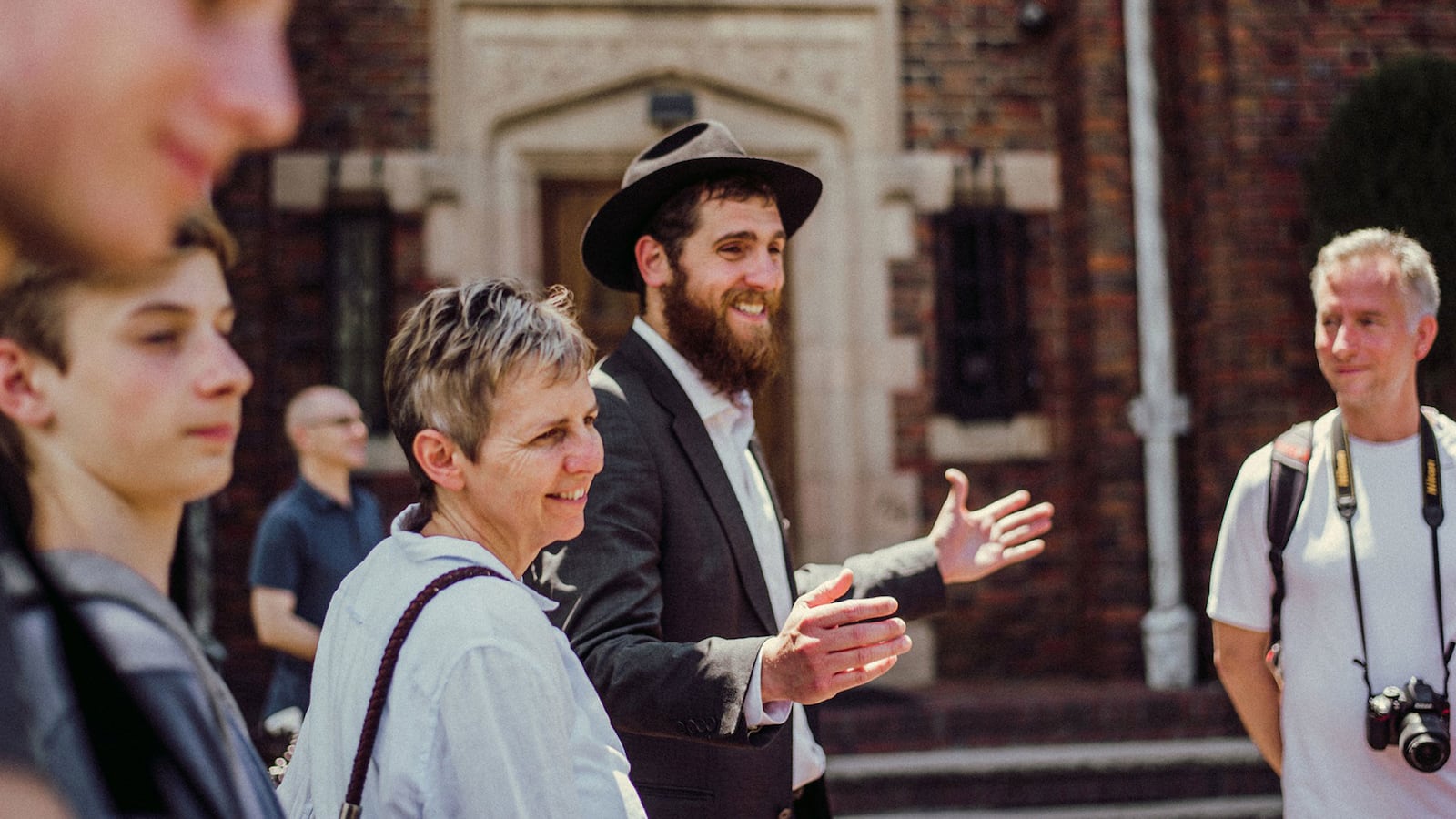There are about five blocks of Crown Heights’ Kingston Avenue that serve as the nerve center for the Hasidic Jews that set up roots in the neighborhood in the ’40s. Every day Rabbi Yoni Katz walks down these blocks crowded with men wearing black hats and women wearing wigs, a crew of unlikely companions in tow. In the past, some of them have been Christian, some Muslim (from as far away as Qatar). One group was all Mormon journalism students from Brigham Young University. There’s also a steady trickle of Reform Jews who come to accompany Katz on this daily walk, knowing as little about the enclosed world of Hasidic Jewry as the Japanese tourists that walk with them.
Katz doesn’t get too many looks from residents as he walks. The residents of Crown Heights are used to visitors. And Katz has been bringing around visitors for a while, as part of his Airbnb experience tour of the Hasidic community in Crown Heights, where people pay $69 a person to go where few non-Jews have gone. For Katz, that’s a selling point. “To many, the Hasidic world is shrouded in mystery and secrecy—well, not anymore,” he writes in his Airbnb advertisement.
The tour begins with a half-hour introduction, in which Katz answers the question on everyone’s minds: Why in the world would the Hasidic community, with its reputation for being isolated and closed off, ever consent to one of these tours? “Crown Heights has never really been closed,” Katz told The Daily Beast. “It might look like it’s full of reclusive Hasidic Jews, but it’s open. It’s always been open to all different kinds of people.”
A Hasid is an ultra-Orthodox Jew who has dedicated their life to following Jewish ritual law to the letter. Every possible aspect of daily existence, from eating to drinking to thinking, must be spiritualized, and to do so there are designated prayers for everything from eating grapefruits to seeing a bolt of lightning to waking up from a confusing dream. Hasids try to live in sheltered communities, hidden from what they call the outside world. Hasidism itself is a mystical movement that began in 18th-century Poland, created in response to what some felt was the strict and limiting emphasis on intellectualism in traditional Judaism. The Hasidic movement still exists today, and has created many subcommunities, like Williamsburg’s Satmers and Crown Heights’ Lubavitchers. The latter is the group Katz has pledged allegiance to, which emphasizes outreach and the welcoming of outsiders.
Katz gives the tours every day, whether the heat is blazing or the cold wind is rattling the trees. Sometimes his wife participates. Sometimes a couple of his seven children trot along. He estimates that he shows the hidden side of Crown Heights to about 50 people a week, on average. Although sometimes there are a hundred people a week and sometimes there are 12. But there’s rarely a day where Katz walks down Kingston Avenue unaccompanied.
The tour moves from a mikve, Jewish ritual bath, to a bakery where the cream cheese dough cookies stuffed with jam and chocolate known as rugelach are had, and then a dress store. There tourists can see women’s wigs and the long black overcoats favored by Hasidic men known as kapotas. If there’s time, visits will be made to a matzah bakery, and if there’s enough advance notice, there will even be the occasional visit inside a Hasidic home.

The tour’s biggest selling point is access. Any tour guide can show you public spaces, but not many can take you inside a Hasidic home, to talk to a Hasidic housewife and ask her if Hasidic women have rights. Common questions include how courtship works, the role of women in the community and if Hasids are allowed to use birth control. (The answer to the latter is yes, on a case-by-case basis.) Katz takes his customers to his mother-in-law’s home, where he encourages them to ask whatever questions they want, no matter how dicey the subject matter.
Has there been pushback from residents, who didn’t consent to being gawked at like creatures at a zoo? Who might bristle at the notion that the tour is making money off their backs? Who might wonder if the commodification of their closed community might mark the end of an era? “I’ve never gotten pushback from the community,” Katz said, and no community members responded to a request for comment.

All proceeds from the tour (and there is a significant amount, given the tour costs $69 a head for a three-hour tour) go to the nonprofit Lubavitch Youth Organization, that offers a children’s library, amongst other services, where Katz is a salaried staff member. The tours actually preceded Airbnb. They used to be given by Beryl Epstein, who prided himself on hosting people of all religions and nationalities and had been doing them since 1982. When Epstein got sick, Katz filled in, and when Epstein passed away at the age of 59, Katz took over.
Katz has a practically perfect 4.97/5 star rating on Airbnb. The comments section is abuzz with compliments. “You get to see a world that you would normally never be able to see on the inside,” one visitor wrote. “Yoni was so welcoming and gave us unprecedented access to the culture, traditions and institutions of the Hasidic community,” wrote another. AirBnB likes it too, designating it one of its top NYC experiences.
Hasidic Crown Heights is a bubble inside a gentrifier’s paradise. Crown Heights might be home to the Brooklyn Museum and the Saturday morning farmer’s market, but it’s also the place where people can find Mermelstein’s Caterers, open since before the ’80s, and 770 Eastern Parkway, the international headquarters of Lubavitch Jews.

Post-World War II, a coterie of Jews followed the Lubavitch Rebbe Yosef Yitzchak Schneersohn to Crown Heights, which was then a mostly-white, monied neighborhood. They were determined to recreate life as it once was before the war. In the ’60s, when the Irish and Italian populations moved out and the African Americans and Carribeans moved in, the Hasids stayed. And they remained there ever since.
You can get there via the 2,3, 4 or 5 trains, but these Crown Heights residents rarely take the train, preferring to live, eat and work within their community. Crown Heights’ restaurant scene is more feted by critics every year, with new tiki bars and burger joints cropping up, but residents won’t ever go. And with every passing month, the value of the faded brownstones on the five blocks near Kingston Ave soars higher and higher, but residents don’t care. They can’t imagine ever leaving.
On some level, the dream of the Hasids, to recreate their Eastern European pre-war lives in America, has come true. The Hasidic Crown Heights of 2019 doesn’t look very different from the Hasidic Crown Heights of 1979. But according to Rabbi Yoni Katz, it isn’t closed, and it never was.






